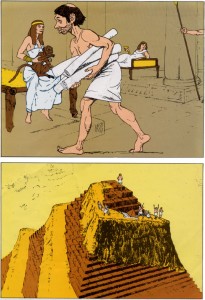D. J.: It’s nice when you see the end result.
T. W.: It is if you feel you are progressing. Running a studio is a heavy responsibility. I was much happier as an animator without the responsibility but as an animator working for somebody else there was no way I could do what I wanted to do. So the price of pushing forward to try and create your own world, is that you have to run a business.
D. J.: How do you divide up the work?
T. W.: Richard and I direct a proportion of the commercials each. I’m a bit more up the sharper end, with clients.

D. J.: What does directing entail for you?
T. W.: Meeting the client and going over the script. Either designing, or organising a designer to create a concept. Drawing each scene and filming it to the sound track, which is called a Leica reel, so that the client can see the basic structure. Animating it yourself or supervising an animator and if there are changes you make those. Presenting it to the client to get their reaction and generally just overseeing.
I find I am animating less and less, much to my annoyance. Someone has to answer the client and often I am involved in more talking than drawing. On Cathedral there were five animation teams, each one had to produce so much footage a week to make the schedule and I had to do both. I was one of the key animators and also the director. I found that directing took up two-thirds of my day and I was falling behind with the footage rate, so I worked in the evening on the animation, sometimes doing sixteen hours a day, and I worked weekends as well. It is impossible to keep doing that, so on Pyramid I am just directing, not animating, unless there is a little sequence that I’d like to do.
D. J.: Do you do layouts when you are directing?
T.W.: In consultation with Richard, I sketch a thumbnail storyboard but Darek Gogol is the one who really constructs most scenes. I just oversee him. Darek does the layouts and we have a seperate artist for the figure work. When we get into animation, because the figures are so realistic, what we are going to do on this one, as opposed to the last one, is get the figure artist to work over the key drawings, to keep the continuity of style. Some animators draw better than others when it comes to a realistic style and you have only got to get a drawing slightly wrong and it looks odd.
D. J.: So he would be the clean-up artist.
T. W.: Yes, but rather than have a team of clean-up artists we will have one who will hit every few drawings.
On Cathedral we cleaned-up the drawings as we animated, as opposed to animating rough and then having a clean-up artist. That is another problem with a limited budget. You can get reasonable quality animation that way but it is hard work.
I was amazed when I visited the Disney studio, they only had to animate a few feet a week and they have people cleaning up behind them. When I told them that our target is fifteen feet of cleaned-up animation a week per animator, they couldn’t believe it. They thought they were hard done by because their rate had been increased to something like seven or eight feet of rough animation a week. Ultimately we would like to get into that situation but to do that you have got to have high budgets and a lot of confidence from backers.
D. J.: And a potential audience as well?
T. W.: I think that if the animation and script are good people will flock to see the film, because they have been starved of quality for a long while. That is why they go to see the old Disney films, it is the only possibility they have of seeing good animation. When you get something like Lord of the Rings there is an initial rush to see it, because of the book’s reputation, but if the animation is bad the word soon gets around and you don’t get the follow through. We have to prove to people who are in a position to finance a feature film, that we can do it. It is hard work but we will get there one day.
page 1 | page 2 | page 3 | page 4 | page 5
Printed in Animator Issue 16 (Summer 1986)
